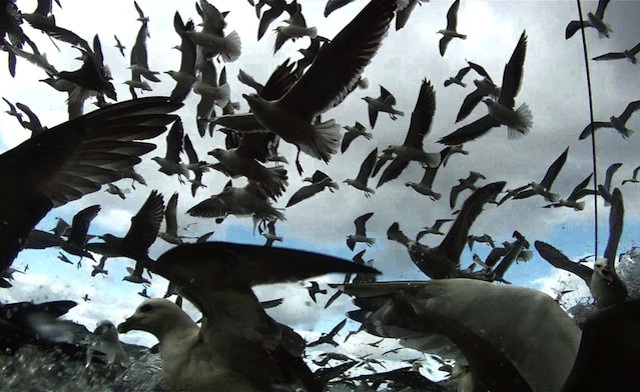Work amidst the biomass

Leviathan (2012) straddles the line between documentary and avant-garde; composed entirely from footage shot on a large fishing boat in the Atlantic Ocean, it hints at how life is lived on the boat, but exists primarily as a visual and auditory experience. Things happen, but there is no plot; our understanding is entirely derived from the images, sound, and what understanding (little, in my case) we might have of industrial fishing.

The film begins, incongruously, with a Bible verse, written in a Gothic-tribal font, then cuts to a black screen with the sound of the ocean churning. A light flickers in the bottom corner of the image, and eventually, we find ourselves on board a massive fishing boat, all clinking chains, painted metal, and winches. During the first ten minutes, we witness, through a camera strapped to one of the workers, the process of bringing up a net that’s been trawling the ocean, and then releasing the mass of slippery silver and pink fish caught in the trap. This labor feels, well, laborious, and has only just begun — when the sequence ends, we notice that light just barely turned the sky from black to navy blue.
The excitement and movement of the opening sequence belies the repetition and drudgery of the work to come. In two later sequences, the camera lingers on the men cleaning the fish, gutting and beheading them with an efficiency that comes from experience. To those unaccustomed to slaughter, the scene is almost enough to turn one to vegetarianism. As the men work, the camera pans down the side of the wooden bin where the newly caught fish are kept, awaiting their fate, to find it caked and dripping with gore. A group of skates are equally doomed; as a fisherman unceremoniously lifts one with meat hooks, another hacks off its wing-like fins and tosses them into a bin. The waste of the fish – heads, guts, and fins – is dumped back into the sea. With the camera sitting on the ship’s steel floor, a fish’s head sits upside down; its bulbous eye stares back at us, as if prompting a response. Then, we cut to another camera half-submerged in the sea, sometimes underwater, other times emerging into the air, as fish viscera slides out the side of the ship in a red sludge. If ever one needed a visual illustration of the term “biomass,” Leviathan offers it.

Matching the unsentimental vision of the labor needed to help feed a population eager for seafood, who in turn are shielded from the violence involved in securing those meals, is a vision of the sea as vast and all-encompassing. Shots where the camera is plunged into the water offer little but darkness and the muffled reverberations of the ship, interrupted only by the white streaks of the wake and the occasional offal. The film’s soundtrack of crashing waves, winches and chains, and the deep rumble of the engines takes on an ominous musical quality in these scenes; so much so that I imagined incidental music emerging just under hearing.
Whereas the scenes of labor lull you with a sense of repetition, the “underwater” sequences transform the sea into an aesthetic, where you glimpse only the occasional recognizable object — a chain, a fish, seagulls when the lens breaks the surface. Leviathan is one part Jeanne Dielman (1975), and one part Dog Star Man (1961-1964), though even together those films are not quite the right comparison. There is something more real, and more accidental, about Leviathan, something to do with the primal in the midst of the industrial. One of the last shots of the film shows one of the fisherman seated in the ship’s kitchen; the garbage from his finished meal litters the table and he looks towards us but slightly off-screen. It sounds like he’s watching Deadliest Catch, and what we can hear — dramatic music, narration, editing — differs so greatly from the experience we’ve just had. As the show continues, the fisherman slowly closes his eyes, obviously exhausted from his work, and the television cuts to a commercial for a colon cleanser — two final reminders of biological reality in this strange approximation of home, deep in the bowels of the floating factory.
—
Roger Ebert was the first film critic I read seriously. For years as a teenager I awaited his reviews every Friday, and his was the first collection of film criticism I ever bought. He taught me that one could disagree with accepted wisdom about a film, and reach one’s own conclusion about it; moreover, he taught me how to defend that opinion. I remember disliking David Lynch’s Blue Velvet (1986) because of Ebert’s review, and after seeing it years later and revising my opinion, his influence remained, because now the lesson had stuck — my conclusion was my own. Although I read him less in recent years, he appeared still as a model of someone who believed in both cinema and humanity. Although it is sometimes difficult to retain a trust in either, this is another of Ebert’s lessons worth remembering.
—
Adam Capitanio lives and works in New York City as an editor and educator. He’s happy to talk to you about any dimension of film art and culture.